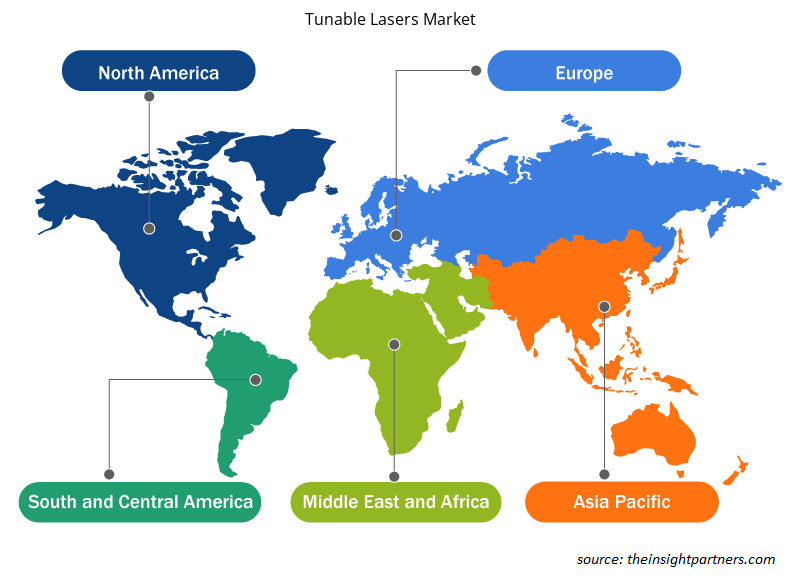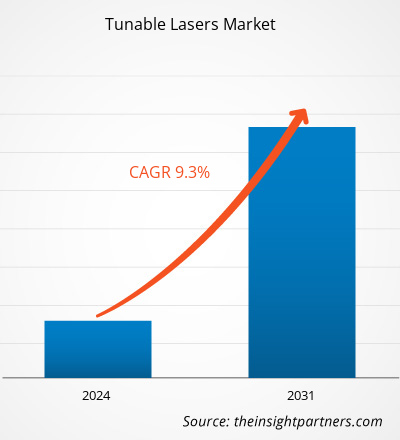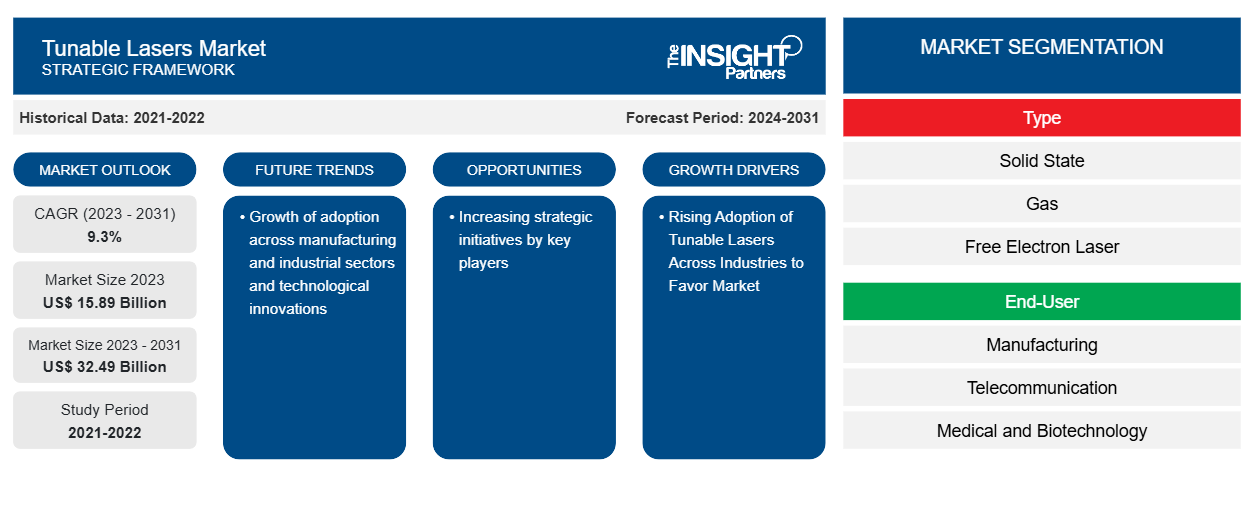Si prevede che la dimensione del mercato dei laser sintonizzabili raggiungerà i 32,49 miliardi di dollari entro il 2031, rispetto ai 15,89 miliardi di dollari del 2023. Si prevede che il mercato registrerà un CAGR del 9,3% nel periodo 2023-2031. Un aumento della capacità dei componenti in fibra ottica attraverso la riconfigurabilità dinamica rimarrà probabilmente una tendenza chiave nel mercato dei laser sintonizzabili.tunable lasers market size is projected to reach US$ 32.49 billion by 2031 from US$ 15.89 billion in 2023. The market is expected to register a CAGR of 9.3% during 2023–2031. An increase in the capacity of fiber optic components through dynamic reconfigurability is likely to remain a key trend in the tunable laser market.
Analisi di mercato dei laser sintonizzabili Lasers Market Analysis
Si prevede che un aumento della capacità dei componenti in fibra ottica attraverso la riconfigurabilità dinamica guiderà ulteriormente la crescita del mercato dei laser sintonizzabili nei prossimi anni. Inoltre, fattori quali innovazioni tecnologiche costanti, prezzi dei prodotti in calo, consolidamenti dei player e una feroce rivalità spingono la domanda di laser sintonizzabili da varie applicazioni, come fotochimica, spettroscopia, comunicazioni ottiche e separazione degli isotopi laser a vapore atomico. Per sviluppare varie tecnologie fotoniche, come rilevamento e misurazione della distanza con luce (LiDAR), fibra ottica, lenti ottiche, studio delle emissioni nucleari e spettroscopia a diodo laser, istituti di ricerca scientifica e università in tutto il mondo si affidano ad apparecchiature di misurazione acute. L'uso diffuso di laser sintonizzabili in fotobiologia, imaging iperspettrale, calibrazione del rilevatore e spettroscopia (riflessione e trasmissione), insieme all'aumento dell'uso di laser sintonizzabili in diverse applicazioni mediche come applicazioni terapeutiche, diagnostiche e trattamenti di ringiovanimento del viso e della pelle basati su laser, sta spingendo la crescita del mercato dei laser sintonizzabili.
Panoramica del mercato dei laser sintonizzabili
Un laser sintonizzabile è un laser con una lunghezza d'onda di funzionamento che può essere riformata in modo controllato. Mentre tutti i media di guadagno laser consentono piccole modifiche nella lunghezza d'onda di uscita, solo alcuni tipi limitati di laser consentono la sintonizzazione continua su un intervallo di lunghezze d'onda considerevole. I laser sintonizzabili consentono di regolare la lunghezza d'onda di uscita a seconda dei casi d'uso. La sintonizzazione ad alta velocità è possibile con alcuni laser sintonizzabili, che sono indicati come agili di lunghezza d'onda o agili di frequenza. Questi laser di solito funzionano in modalità continua con una larghezza di banda di emissione stretta.
Personalizza questo report in base alle tue esigenze
Riceverai la personalizzazione gratuita di qualsiasi report, comprese parti di questo report, o analisi a livello nazionale, pacchetto dati Excel, oltre a usufruire di grandi offerte e sconti per start-up e università
-
Scopri le principali tendenze di mercato in questo rapporto.Questo campione GRATUITO includerà analisi di dati che spaziano dalle tendenze di mercato alle stime e alle previsioni.
Driver e opportunità del mercato dei laser sintonizzabili
Crescente adozione di laser sintonizzabili in tutti i settori per favorire il mercato
La crescente adozione di laser sintonizzabili in vari settori sta sicuramente guidando la crescita del mercato dei laser sintonizzabili. Questi laser sono frequentemente utilizzati nella produzione, nelle telecomunicazioni, in medicina e biotecnologia, nell'aerospaziale, nell'elettronica e nei semiconduttori, nell'industria e in altri settori. Ognuno di questi settori sta crescendo di anno in anno, il che si traduce in una domanda crescente di laser sintonizzabili. Inoltre, i laser sintonizzabili si concentrano su architettura e tecnologia. Sono utili in astronomia, aviazione, energia, comunicazioni, difesa, imaging, interferometria, medicina, microscopia e spettroscopia . Pertanto, considerando i parametri di cui sopra, la crescente domanda di laser sintonizzabili sta guidando il mercato dei laser sintonizzabili.tunable lasers across various industries is definitely driving the growth of the tunable laser market. These lasers are frequently used in manufacturing, telecommunication, medical and biotechnology, aerospace, electronics and semiconductor, industrial, and others. Each of these industries is growing year on year, which is resulting in the surging demand for tunable lasers. Further, the tunable lasers focus on architecture and technology. They are beneficial in astronomy, aviation, energy, communications, defense, imaging, interferometry, medicine, microscopy, and tunable lasers is driving the tunable lasers market.
Incremento delle iniziative strategiche da parte degli attori chiave.
I principali attori del mercato stanno prendendo varie iniziative come lanci di prodotti, partnership e strategie organiche e inorganiche per guidare la crescita del mercato. Ad esempio, a dicembre 2023, LioniX International ha introdotto un innovativo laser integrato sintonizzabile ad alta precisione che funziona a 1310 nm nella banda O, puntando ad applicazioni ad alta crescita nel rilevamento ottico e nelle comunicazioni ottiche. La collaborazione tra LioniX, Sivers Photonics e Chilas ha dato vita a questo laser, appena uscito dal laboratorio e pronto a ridefinire gli standard del settore. Inoltre, molte altre aziende stanno prendendo l'iniziativa, il che offrirà alcune potenziali opportunità per il mercato.LioniX International introduced an innovative high-precision integrated tunable laser that operates at 1310 nm in the O-band, aiming for high-growth applications across optical sensing and optical communications. The collaboration between LioniX, Sivers Photonics, and Chilas gave rise to this laser, hot off the lab bench and ready to redefine industry standards. Moreover, many other companies are taking the initiative, which will hold some potential opportunities for the market.
Analisi della segmentazione del rapporto di mercato dei laser sintonizzabili
I segmenti chiave che hanno contribuito alla derivazione dell'analisi di mercato dei laser sintonizzabili sono tipologia, causa, utente finale, tecnologia e lunghezza d'onda.
- In base al tipo, il mercato dei laser sintonizzabili è suddiviso in stato solido, gas, laser a elettroni liberi (FEL) e altri. Si prevede che il segmento a stato solido detenga una quota di mercato significativa nel periodo di previsione.
- In base all'utente finale, il mercato è segmentato in produzione, telecomunicazioni, medicina e biotecnologia, aerospaziale, elettronica, semiconduttori, industriale e altri. Si prevede che il segmento manifatturiero detenga una quota di mercato significativa nel periodo di previsione.
- In termini di tecnologia, il mercato è diviso in laser a diodo a cavità (DBR), laser a riflettore Bragg distribuito (DFB), laser a emissione superficiale a cavità verticale (VCSEL), sistemi microelettromeccanici (MEMS) e altri. Si prevede che il segmento laser a diodo a cavità (DBR) detenga una quota di mercato significativa nel periodo di previsione.
Analisi della quota di mercato dei laser sintonizzabili per area geografica
L'ambito geografico del rapporto sul mercato dei laser sintonizzabili è suddiviso principalmente in cinque regioni: Nord America, Asia Pacifico, Europa, Medio Oriente e Africa, e Sud e Centro America.
Il Nord America ha dominato ilmercato laser sintonizzabile. Le tendenze di adozione di tecnologie elevate in vari settori della regione nordamericana hanno alimentato la crescita del mercato sintonizzabile. Si prevede che fattori come l'adozione crescente della tecnologia digitale e l'elevata spesa tecnologica da parte delle agenzie governative guideranno la crescita del mercato laser sintonizzabile nordamericano. Inoltre, una forte enfasi sulla ricerca e sviluppo nelle economie sviluppate degli Stati Uniti e del Canada sta costringendo gli operatori nordamericani a portare sul mercato soluzioni tecnologicamente avanzate. Inoltre, gli Stati Uniti hanno un gran numero di operatori del mercato laser sintonizzabile che si sono sempre più concentrati sullo sviluppo di soluzioni innovative. Tutti questi fattori contribuiscono alla crescita del mercato laser sintonizzabile nella regione.
Laser sintonizzabile
Approfondimenti regionali sul mercato dei laser sintonizzabili
Le tendenze regionali e i fattori che influenzano il mercato dei laser sintonizzabili durante il periodo di previsione sono stati ampiamente spiegati dagli analisti di Insight Partners. Questa sezione discute anche i segmenti e la geografia del mercato dei laser sintonizzabili in Nord America, Europa, Asia Pacifico, Medio Oriente e Africa e America meridionale e centrale.

- Ottieni i dati specifici regionali per il mercato dei laser sintonizzabili
Ambito del rapporto di mercato sui laser sintonizzabili
| Attributo del report | Dettagli |
|---|---|
| Dimensioni del mercato nel 2023 | 15,89 miliardi di dollari USA |
| Dimensioni del mercato entro il 2031 | 32,49 miliardi di dollari USA |
| CAGR globale (2023-2031) | 9,3% |
| Dati storici | 2021-2022 |
| Periodo di previsione | 2024-2031 |
| Segmenti coperti |
Per tipo
|
| Regioni e Paesi coperti |
America del Nord
|
| Leader di mercato e profili aziendali chiave |
|
Densità dei player del mercato dei laser sintonizzabili: comprendere il suo impatto sulle dinamiche aziendali
Il mercato dei laser sintonizzabili sta crescendo rapidamente, spinto dalla crescente domanda degli utenti finali dovuta a fattori quali l'evoluzione delle preferenze dei consumatori, i progressi tecnologici e una maggiore consapevolezza dei vantaggi del prodotto. Con l'aumento della domanda, le aziende stanno ampliando le loro offerte, innovando per soddisfare le esigenze dei consumatori e capitalizzando sulle tendenze emergenti, il che alimenta ulteriormente la crescita del mercato.
La densità degli operatori di mercato si riferisce alla distribuzione di aziende o società che operano in un particolare mercato o settore. Indica quanti concorrenti (operatori di mercato) sono presenti in un dato spazio di mercato in relazione alle sue dimensioni o al valore di mercato totale.
Le principali aziende che operano nel mercato dei laser sintonizzabili sono:
- Corporazione coerente
- Leonardo DRS
- Società a responsabilità limitata
- Fotonica HÜBNER
- Tecnologie Keysight
- Luna Innovations Incorporated
Disclaimer : le aziende elencate sopra non sono classificate secondo un ordine particolare.

- Ottieni una panoramica dei principali attori del mercato dei laser sintonizzabili
Notizie di mercato e sviluppi recenti sui laser sintonizzabili
Il mercato dei laser sintonizzabili viene valutato raccogliendo dati qualitativi e quantitativi dopo la ricerca primaria e secondaria, che include importanti pubblicazioni aziendali, dati di associazioni e database. Di seguito sono elencati alcuni degli sviluppi nel mercato dei laser sintonizzabili:
- Pilot Photonics ha annunciato la disponibilità di un nuovo modulo laser ampiamente sintonizzabile. È l'unico laser sintonizzabile disponibile in commercio che offre l'elusiva combinazione di commutazione al nanosecondo e larghezza di linea stretta, risolvendo una sfida di lunga data nel settore.
(Fonte: sito web della Pilot Photonics Company, gennaio 2023)
- Sivers Semiconductors AB ("Sivers") ha annunciato che la sua controllata, Sivers Photonics, ha avviato una nuova partnership con LioniX International e Chilas BV per sviluppare e fornire un laser O-Band CW Tunable a 1310 nm integrato a larghezza di linea stretta, destinato ad applicazioni ad alta crescita nei settori delle comunicazioni ottiche e della rilevazione ottica.
(Fonte: Sivers Semiconductors AB, sito Web aziendale, dicembre 2023)
Copertura e risultati del rapporto sul mercato dei laser sintonizzabili
Il rapporto "Dimensioni e previsioni del mercato dei laser sintonizzabili (2021-2031)" fornisce un'analisi dettagliata del mercato che copre le seguenti aree:
- Dimensioni e previsioni del mercato dei laser sintonizzabili a livello globale, regionale e nazionale per tutti i principali segmenti di mercato trattati nell'ambito dell'indagine.
- Tendenze del mercato dei laser sintonizzabili e dinamiche di mercato quali driver, limitazioni e opportunità chiave.
- Analisi dettagliata delle cinque forze PEST/Porter e SWOT.
- Analisi di mercato dei laser sintonizzabili che copre le principali tendenze del mercato, il quadro globale e regionale, i principali attori, le normative e i recenti sviluppi del mercato.
- Analisi del panorama industriale e della concorrenza che comprende la concentrazione del mercato, l'analisi delle mappe di calore, i principali attori e gli sviluppi recenti per il mercato dei laser sintonizzabili.
- Profili aziendali dettagliati.
- Analisi storica (2 anni), anno base, previsione (7 anni) con CAGR
- Analisi PEST e SWOT
- Valore/volume delle dimensioni del mercato - Globale, Regionale, Nazionale
- Industria e panorama competitivo
- Set di dati Excel
Report recenti
Rapporti correlati
Testimonianze
Motivo dell'acquisto
- Processo decisionale informato
- Comprensione delle dinamiche di mercato
- Analisi competitiva
- Analisi dei clienti
- Previsioni di mercato
- Mitigazione del rischio
- Pianificazione strategica
- Giustificazione degli investimenti
- Identificazione dei mercati emergenti
- Miglioramento delle strategie di marketing
- Aumento dell'efficienza operativa
- Allineamento alle tendenze normative























 Ottieni un campione gratuito per - Mercato dei laser sintonizzabili
Ottieni un campione gratuito per - Mercato dei laser sintonizzabili